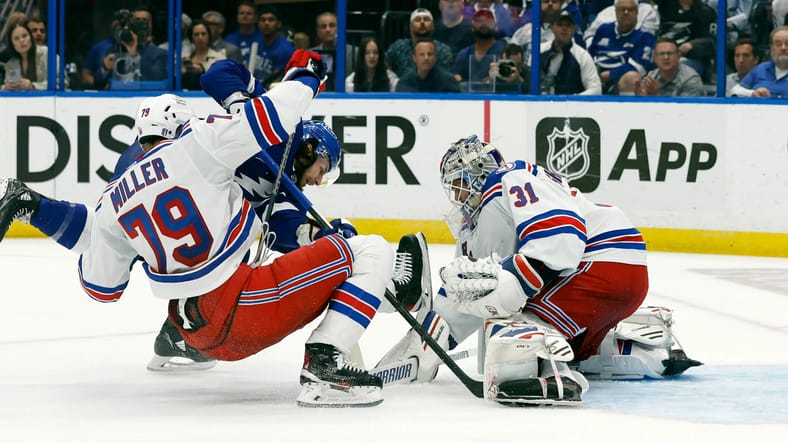
As we all wake up and deal with the Rangers loss in the Eastern Conference Final, we get a chance to take a step back and realize what the Rangers accomplished this season. The last four games were a kick in the teeth, but there are three NY Rangers takeaways from this series that they can apply to next season, when they make another run.
NY Rangers takeaway #1: A goalie makes a difference, but it doesn’t guarantee success
The Rangers should have learned that a goalie doesn’t guarantee success during the Henrik Lundqvist years. But here we are, wondering if “any team can beat Igor Shesterkin four times in seven games.” Well it almost happened twice before Tampa did it in six games. Henrik Lundqvist never won a Stanley Cup because the Rangers ignored their flaws, or because Lundqvist covered them up.
Shesterkin is in the same situation. He covered up many Rangers flaws this postseason, and that’s fine for a first cut at it. But his magnificence in net shouldn’t overshadow that the Rangers have clear holes on the roster, in the process, and how to win in the postseason.
Early on, the Rangers defense was abysmal. Then it was their offense that couldn’t score. A goalie can cover up the defense to a degree, but a goalie can’t score.
NY Rangers takeaway #2: You have to score at even strength
The Rangers scored one goal at even strength in their four losses in the series. That goal was scored by Ryan Lindgren at a bad angle. In the final three games, the Rangers mustered just one goal per game. Powerplay opportunities run dry in spurts, especially in the postseason. The Rangers had an issue scoring at even strength all season, and Tampa exposed it in the playoffs.
The concern with the Rangers isn’t that they don’t have the talent, it’s that they simply don’t score at even strength. Their offense is based almost entirely off stretch passes, counter attacks, and rush chances. Tampa shut that down in quick succession, first with the cross-slot passes then with the rush/stretch passes.
The kid line was the only line for the Rangers able to generate any sustained offense off the rush, and that was a major problem. The second line was atrocious against the Lightning, while the top line got completely shut down by Anthony Cirelli. You need to be able to generate offense in multiple different ways, and the Rangers showed they were a one trick pony.
NY Rangers takeaway #3: You can’t ignore the fourth line
The Rangers got one empty net goal from the fourth line. One. That’s it. And honestly, that’s fine in certain situations. If the fourth line is a shutdown line, then one goal is fine if the fourth line is shutting down the opposition’s top players.
Going back to Anthony Cirelli, his like was tasked with shutting down Mika Zibanejad, which he did. The line didn’t contribute much offense, and it didn’t have to thanks to Tampa’s top line, which did not get shut down at all. The Rangers fourth line was there just to give the top nine a rest. That’s not a fourth line with a role or a purpose, something Chris Drury was big on.
Many will focus on the 2C need, and perhaps the need up and down RW, but the fourth line should not be ignored. They need a role. If the Rangers go with a third line that’s a shutdown line, then the fourth line should have some speed and scoring ability. If the third line is that matchup-based offensive line, then the fourth line is the shutdown line.
The days of the minutes eaters are gone. The Rangers need a fourth line with a role. Tampa has one. Colorado has one. They are the two teams left standing. That is not a coincidence.
Share:
More About:Playoffs
